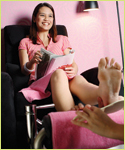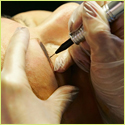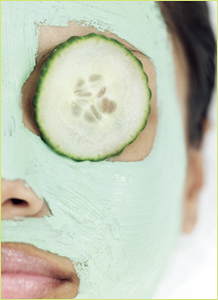Spa services aren't always as safe as you think. Here's how to protect yourself.
Compared with the abundance of information promoting spa services to make you feel more relaxed, more attractive, pampered, and of course, younger, there's little out there to tell you about their safety. Many of these services* require special training to administer or should be done only by physicians. And some should be completely avoided.
"I think it's just a lot of cases of buyer beware," says Bruce Katz, M.D. "People have to have a good healthy skepticism that those performing the service are properly trained and have experience with the device that they are using." Dr. Katz is the Clinical Professor of Dermatology at The Mount Sinai School of Medicine, Director of the Cosmetic Surgery & Laser Clinic at Mount Sinai Medial Center, and Director of the Juva Skin & Laser Center in New York.
![]() CAUTION
CAUTION
For the service below, try to find the best salon in your area by asking friends for recommendations.
Facials. According to Dr. Katz, as long as the service is performed in a clean environment by a properly trained technician, a facial is a pretty low-risk service. Next to cleanliness, the most important consideration is to be sure you are not allergic to any of the ingredients applied to your skin, he notes. If you have allergies, ask what's in the products ahead of time. The same is true of body wraps.
![]() MUCH CAUTION
MUCH CAUTION
Do research to find the best salon or spa in your area that provides the services below. Pay attention to what the technician is doing, and be sure to ask questions if something doesn't seem right.
 Manicure/Pedicure. The greatest risk here is of infection, especially for the feet since they spend so much time in shoes—bacteria grow better where it's warm and dark. To reduce your risk of infection, don't shave within a day of a pedicure, wait for any cuts or wounds to heal before getting a manicure/pedicure, and have your cuticles pushed back rather than removed. Consider bringing your own instruments to be sure they're always clean. Just boil them between uses. You can find more information at the International Pedicure Association.
Manicure/Pedicure. The greatest risk here is of infection, especially for the feet since they spend so much time in shoes—bacteria grow better where it's warm and dark. To reduce your risk of infection, don't shave within a day of a pedicure, wait for any cuts or wounds to heal before getting a manicure/pedicure, and have your cuticles pushed back rather than removed. Consider bringing your own instruments to be sure they're always clean. Just boil them between uses. You can find more information at the International Pedicure Association.
It's also important to make sure there's adequate ventilation. If the place smells like an auto body shop, find another salon.
Waxing. Waxing should not be done on people with diabetes or those with thin or fragile skin since it can easily tear skin, causing injury. Waxing also shouldn't be done over varicose veins, moles, or warts or if the skin is chapped, sunburned, or otherwise irritated. To reduce the risk of burns, ask the technician to check the temperature of the wax before applying it to your skin.
Microdermabrasion. This includes a number of techniques to remove the uppermost layer of the skin on the face for a smoother appearance. Besides infection, you could also experience injury if the treatment isn't done properly. Keep in mind that this service is highly unregulated by the government. That's why, if you're considering microdermabrasion, it would be best to have it done by your dermatologist rather than a salon technician.
![]() EXTREME CAUTION
EXTREME CAUTION
Before having the services below, do lots of research on them and where to have them done. Read information from the Centers for Disease Control and Prevention and the U.S. Food and Drug Administration.
LASER hair removal. LASER (Light Amplified by Stimulated Emission of Radiation) is a powerful light therapy that is used for everything from shrinking tumors to tightening the skin for cosmetic purposes. There are a number of LASER types, each used for a different purpose. The one used for hair removal destroys the hair's growth at the cellular level.
LASER is a powerful device that should only be administered by well-trained and experienced technicians and physicians. In fact, in some states—like New Jersey—only a medical doctor can legally perform LASER hair removal. And it's important to understand why: Risks include burning, scarring, changes to skin color (especially darker skin), and permanent damage to the eyes, including blindness. Even those outside the treatment room can be hurt if the LASER is allowed to reflect into those areas through a window or door.
If you are considering LASER hair removal, read as much about it as you can ahead of time, and choose a well-trained, licensed expert. Be sure that the person treating you provides protective eyewear, and never have LASER hair removal performed around your eye area or eyebrows.
 Permanent makeup. Permanent makeup is applied by tattooing pigments into the skin. Some people choose permanent makeup because they can't see well enough to apply makeup or because they have a disability that makes it difficult to do. Permanent makeup is also used as part of some reconstructive procedures, including total breast reconstruction.
Permanent makeup. Permanent makeup is applied by tattooing pigments into the skin. Some people choose permanent makeup because they can't see well enough to apply makeup or because they have a disability that makes it difficult to do. Permanent makeup is also used as part of some reconstructive procedures, including total breast reconstruction.
If you're considering getting permanent makeup to save time, it probably isn't a good idea. The greatest risk is of infection, which can occur years after the makeup is applied. After that, you should consider that the inks aren't regulated by the U. S. Food and Drug Administration—some of them include industrial grades, which could be used in printers and car paint.
And if you decide you don't like it later, removal is painful, and often requires multiple visits, even using the latest laser technology. Another problem is that permanent makeup (and tattoos) can interfere with the readability of MRIs (magnetic resonance imaging). After having MRIs, some people have also reported swelling or burning in the area where their tattoo is.
![]() COMPLETELY AVOID
COMPLETELY AVOID
The services below should be avoided completely. The risks of injury far outweigh any benefits.
 Tanning. "Indoor tanning is a definite no no," says Dr. Katz. "Due to the risk of melanoma, it should be avoided."
Tanning. "Indoor tanning is a definite no no," says Dr. Katz. "Due to the risk of melanoma, it should be avoided."
The largest factor in your potential to develop skin cancer is your exposure to ultraviolet (UV) radiation. Since UV radiation in indoor tanning devices is 15 times greater than what you'd get outdoors on a sunny day, indoor tanning greatly increases your risk of developing melanoma, which is the deadliest form of skin cancer. It also causes premature wrinkling. If you'd like to look tanned, it's safer to use a sunless tanning product.
Ear candling (coning). Ear candling is downright dangerous, with scores of people reporting burns. So it should be completely avoided. As part of ear candling, the provider places the cone-shaped end of a candle-like tube in your ear, lights the opposite end, and allows it to burn for about 15 minutes. After the tube is removed, a stick is inserted into the tube to push out the debris inside it. It's claimed that this debris has been cleared from your ear, sinuses, and even your brain! However, studies have proved that the debris collected inside the tube is only from the candle, not the ear or any other body part. If you think your ears need to be professionally cleaned, it's best to contact a licensed physician.
*Please note: Services performed for cosmetic reasons are not covered
by health insurance.





